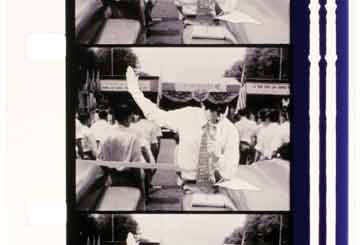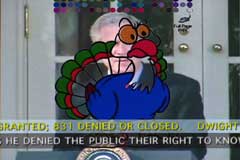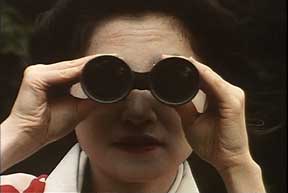|
March 30th, Sunday, 5:00PM
 Coolidge Corner Theatre Coolidge Corner Theatre
290 Harvard St, Brookline, MA
Tickets: $7
Balagan Film Series presents:
Lin plus Lam with Lana Lin & H. Lan Thao Lam in attendance
Lin + Lam (Lin plus Lam) produce interdisciplinary projects that examine the ramifications of the past for the current socio-political moment. Informed by documentary and experimental cinema, Lana Lin's films interpret different cultural contexts, raising questions about the politics of translation and the processes of identification. Trained in architecture, H. Lan Thao Lam uses photography, sculpture, and installation to probe the construction of history and lived places. Their collaborative work has been exhibited in international venues including the Museum of Modern Art, NY, Los Angeles Contemporary Exhibitions, the China Taipei Film Archive, Creteil International Women's Film Festival, and the London Film Festival, among others.
Departure, a video essay they shot in Taiwan, China, and Vietnam, premiered in the Asian Vision Competition at the Taiwan International Documentary Film Festival. Dark Meat or White Meat?, their short video about the absurd power of the US Presidential pardon, was shown at video_dumbo and LMAKprojects in Chelsea, New York. Unidentified Vietnam No. 18–the culmination of six years research–is their first collaborative 16mm film.
Program:
Unidentified Vietnam No.18 (30 mins) 16mm, 2007

In 1975, after the fall of Saigon, the Library of Congress acquired a collection of 1950-70's films from the South Vietnam Embassy. Unidentified Vietnam No. 18 is a successor to the seventeen films in the collection labeled only as “Unidentified Vietnam, #1-17”. Lin + Lam's personal, experimental film examines the contested relationship between Vietnam and the US, between history and propaganda, between democracy and nation building.
Situated within the present, an archivist, film scholar, and South Vietnamese-in-exile speculate upon the intention of the war-era films. The filmmakers mine the material artifacts of the archive, fingering deteriorating film labels and paging through catalogue lists, and inhabit the past by re-enacting propagandistic gestures. Spectral images salvaged from a now non-existent republic haunt mausoleum-like hallways, reminding us of what remains unidentifiable in the process of recovery. Through these actions of retrieval and remembrance, the film ponders how US intervention has failed, and considers the dangers of its repetition.
Dark Meat or White Meat? (15 mins), video 2006
 Every Thanksgiving since 1987 the US President has pardoned two turkeys so that 45 million may be slaughtered guilt-free. The annual turkey pardon exemplifies the absurd and arbitrary exercise of executive authority. With the President's sweeping powers, questions of life and death, freedom and imprisonment, hinge upon taste and personal preference akin to the choice of dark or white meat. The video offers counter-narratives as commentary on this highly prejudicial process: a humorous history of turkey pardon ceremonies contrasted with tickertape statistics detailing controversial pardons and the plummeting number of pardons granted since the 1980's. Every Thanksgiving since 1987 the US President has pardoned two turkeys so that 45 million may be slaughtered guilt-free. The annual turkey pardon exemplifies the absurd and arbitrary exercise of executive authority. With the President's sweeping powers, questions of life and death, freedom and imprisonment, hinge upon taste and personal preference akin to the choice of dark or white meat. The video offers counter-narratives as commentary on this highly prejudicial process: a humorous history of turkey pardon ceremonies contrasted with tickertape statistics detailing controversial pardons and the plummeting number of pardons granted since the 1980's.
Mizu Shobai (Water Business), 12 min. 16mm film by Lana Lin, 1993
"Through lyrical images and narrative shards, Lin builds a critique of the ways in which the figure of the Japanese woman exists in the imaginary." (Manohla Dargis, LA Weekly)
Mizu Shobai (Water Business) blends two stories, one of a geisha who is lost at sea and another of the first geisha to circle the world. The dual narratives collapse into a single female figure, a traveler through time and across cultures. Carried by the act of perception, the geisha drifts beyond the prescribed bounds of "her place" in the world. The Shogun's Seclusion Edict (1637-1868,) the historical period of Japanese isolation, states that foreign influence is punishable by death, so that the geisha's passive observations become an active, fatal offense. Mizu Shobai's lush visuals invite the viewer to be enticed by exoticism, but since the narrative is not overt, the viewer remains an outsider, as distanced as the geisha is to her surroundings. As a reference to its subject, the film's structure is based on an ocean wave pattern. Always slightly beyond grasp, information is introduced, recedes, and repeats. The narrative is not driven but must be pieced together, asking the viewer to consider how exoticism and perception work. Mizu Shobai literally translates as “water business,” which is the Japanese term for the entertainment world. Encompassing layers of meaning, the phrase refers to liquor and sex, as well as the geisha's stereotyped maudlin lifestyle, which “flows like water.”
|
